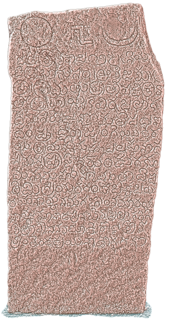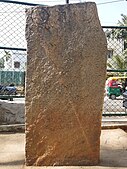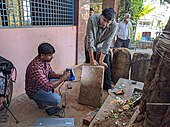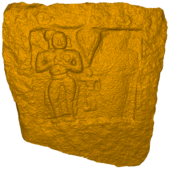Jakkur inscriptions and hero stones

Jakkur, a suburb in Bengaluru is an old locality that has an historicity of about 700 years. The locality is home to four inscriptions and several hero stones.[1][2] The earliest inscriptions of the area can be paleographically dated to 9th - 10th century CE.[3] These inscriptions also indicate that Jakkur Lake, regarded as one of the biggest lakes of Bangalore, existed as old as seven centuries ago.
Two hero stones, one a self-sacrifice memorial stone from the 14th century and another a Maha-Satistone from the 16th-17th centuries are also found at Jakkur.
Jakkur 1432 CE God Allalanatha inscription
[edit]| Allalanatha inscription | |
|---|---|
 3D Scanned image of the Allalanatha inscription | |
| Material | Stone |
| Height | 62 cm (24 in) |
| Created | 1432 |
| Discovered | 2021 Jakkur, Bengaluru |
| Present location | 30°04′45″N 77°36′27″E / 30.07925000°N 77.60761111°E |
| Language | Kannada |
| https://mythicsociety.github.io/AksharaBhandara/#/learn/Shasanagalu?id=115075 | |
It is a Kannada inscription which records the donation of a Garuda pillar to an Allalanatha temple in 1432 CE. As the letters of the inscription are worn out, the full inscription cannot be deciphered.[4]
Discovery and dating
[edit]The inscription was discovered in December 2021 by the side of a road by citizen researchers K R Narasimhan and Dhanpal Manchenahalli.[5] Subsequently, the inscription was shifted to nearby ground. It can be precisely dated to April 10, 1432 CE according to the Julian calendar as it mentions the date as "jayābhyudaya varuṣa 1354 paridāvi saṃ cayitra su 10".
Transliteration of the inscription
[edit]Digital Images of the each of the characters of this inscription, images of the inscription itself, summary and the other information about the inscription have been shared via Aksharabhandara Software
The inscription consists of 9 lines. The transliterated text of the inscription in Kannada and IAST are as follows:
| Line
Number |
Kannada | IAST |
|---|---|---|
| 1 | [ಜ]ಯಾಭ್ಯುದ | [ja]yābhyuda |
| 2 | [ಯ ವ] ರುಷ ೧೩೫ | [ya va] ruṣa 135 |
| 3 | (೪) [ಪ] ರಿದಾವಿ ಸಂ | (4) [pa] ridāvi saṃ |
| 4 | [ಚ] ಯಿತ್ರ ಸು ೧೦ | [ca] yitra su 10 |
| 5 | ಅಲ್ಲಾಳನಾತ | allāl̤anāta |
| 6 | . ಕ . ಸಮುದ್ರ | . ka . samudra |
| 7 | ೦ಮಿಸಿತ್ತ | ṃmisitta |
| 8 | . . ಸೇವೆ | . . sevĕ |
| 9 | . . . ಕಂಬ | . . . kaṃba |
Jakkur 1000 CE Kalnadu inscription
[edit]| Jakkur Kalnad inscription | |
|---|---|
 3D Scanned image of The Jakkur 10th century Kalnadu Kannada Inscription | |
| Material | Stone |
| Height | 75 cm (30 inches) |
| Width | 75 cm (30 inches) |
| Writing | Kannada script |
| Created | 10th century CE |
| Discovered | 2017 Jakkur |
| Present location | 13°04′48″N 77°36′37″E / 13.0799726°N 77.6101814°E |
| Language | Kannada |
| https://mythicsociety.github.io/AksharaBhandara/#/learn/Shasanagalu?id=1041000 | |
It is a Kannada inscription paleographically dated to the 10th century CE that documents the donation of a village to a Sanjayappa, the villages that were donated to the family of martyrs who died protecting the village or the kingdom was called as kalnad/kalnatu. The inscription documents a word "Jakkiyu" which either might be the old name of Jakkur or a substitute word for "Yakshi" name of Jakkur. This inscription was discovered by researchers K. R. Narasimhan and P. L. Udaya Kumar in 2017.[6]
Transliteration of the inscription
[edit]Digital Images of the each of the characters of this inscription, images of the inscription itself, summary and the other information about the inscription have been shared via Aksharabhandara Software
The inscription is of 6 lines and the transliterated text of the inscription is as follows,
| Line
Number |
Kannada | IAST |
|---|---|---|
| 1 | . . . . . ಮ್ಮಕಲಿಗ ಸ | . . . . . mmakaliga sa |
| 2 | . . . . . ಣ್ನನಾಡ ಜಕ್ಕಿಯೂ | . . . . . ṇnanāḍa jakkiyū |
| 3 | . . .. . .. ಸಲಗುವ ಸಂಜಪಯ್ಯನುಂ | . . .. . .. salaguva saṃjapayyanuṃ |
| 4 | . . . . . ಮೞಿದವಂ ಕವಿಲೆ ಬಾರ | . . . . . maḻidavaṃ kavilĕ bāra |
| 5 | . . . . .ೞಿದ೦ ಇ ಕಲ್ನಾಡು ಗುದುರಾ | . . . . .ḻida0 i kalnāḍu gudurā |
| 6 | . . . .. . . . ನೆನ್ದಕಮಾಲೆಗೊಟ್ಟ | . . . .. . . . nĕndakamālĕgŏṭṭa |
Translation
[edit]Kalnadu was given to Sanjapayya of Sunnadu (small country) Jakkur, He who destroyed it the inscription records the curse that Kavile was killed in Varanasi.
Jakkur 10th Century Prashasti inscription
[edit]| Jakkur Prashasthi inscription | |
|---|---|
 3D Scanned image of The Jakkur 10th century Prashasti Kannada Inscription | |
| Material | Stone |
| Height | 72 cm (28 inches) |
| Width | 108 cm (43 inches) |
| Writing | Kannada script |
| Created | 10th century CE |
| Discovered | Jakkur |
| Present location | 13°04′44″N 77°36′26″E / 13.0789983°N 77.607214°E |
| Language | Kannada |
| https://mythicsociety.github.io/AksharaBhandara/#/learn/Shasanagalu?id=115150 | |
It is a Kannada inscription paleographically dated to the 10th century CE and is a significant epigraphic record found in the village of Jakkur. The inscription records a conflict between Ballavathirayanna, the ruler of Navalakka, and Birudasedeva of Gubetta, it also documents that Jakkuru village belonged to Gangavadi thombattaru savira, an administrative division that came into existence since the Western Gangas.[7][8]
Discovery and dating
[edit]This inscription was discovered by KR Narasimhan and Dhanapal Manchenahalli which was lying in a field partially buried, subsequently with the cooperation of locals Srikanthappa, Ravigowda, Nagarajappa and Srinivas, it was shifted to KV Bhairegowda Kalamandir.[8] The inscription is paleographically dated to the 10th century CE.
Transliteration of the inscription
[edit]Digital Images of the each of the characters of this inscription, images of the inscription itself, summary and the other information about the inscription have been shared via Aksharabhandara Software
The inscription is of 5 lines, and the transliterated text of the inscription in Kannada and IAST is as follows[9]
| Kannada | IAST | |
|---|---|---|
| 1 | ಮ ದ ಗಾಳಂಗವಾಡಿ ತೊಂಭತ್ತುಸಾಯಿ | . . ma . da gāl̤gaṃgavāḍi tŏṃbhattaṟusāyi |
| 2 | ರಮನೇಕ ಛತ್ರಚ್ಛಾಯೆಯೊಳರಸುಗೆಯ್ಯು | ramaneka chatracchāyĕyŏl̤arasugĕyyu |
| 3 | ತಿರೆ ಸ್ವಸ್ತಿ ಸಮಸ್ತ ಪ್ರಸಸ್ತಿ ಸಹಿತ ಶ್ರೀ ಮತ್ | ttirĕ svasti samasta prasasti sahita śrīmat |
| 4 | ನವಲಕ್ಕದಹಳಾಧಿಪತಿಯಪ್ಪ ಬಲ್ಲವ | navalakkadahal̤ādhipatiyappa ballava |
| 5 | ತಿರಾಯಂ ಗೊಬೆಟ್ಟದ ಬಿರುದಸೆದೇವನ ಕಾಳೆಗ | tirāyaṃ gŏbĕṭṭada birudasĕdevana kāl̤ĕga |
Jakkur 1342 CE Honnamarayanayaka Donation Inscription
[edit] Text on the frontal face | |
 Text on the back face | |
| Language | Tamil |
|---|---|
| Height | 143 cm (56 in) |
| Width | 72 cm (28 in) |
| Discovered place | Jakkur, Bengaluru, Karnataka |
| Discovered | 1905 |
| Present location | 13°04′44″N 77°36′26″E / 13.07891667°N 77.60725000°E |
| Symbols | Sun, Moon |
| https://mythicsociety.github.io/AksharaBhandara/#/learn/Shasanagalu?id=1011342 | |
It is one of the significant inscriptions that help in constructing the history of Jakkur. It is a Kannada inscription that records the donation of tax-exempt irrigated, rain-fed, pastoral and waste lands of Jakkur belonging to the dominion of Honnamaranayaka, a local feudal lord, to the nad senabhova (ನಾಡ ಸೇನಭೋವ) Allala, nad senabhova were a rank of tax officers responsible for collecting tax of a village.[10] The area during the time was ruled by the Hoysala king Veeraballala III from his capital, Unnamale pattana, the historical name of Tiruvannamalai in Tamil Nadu.[11] The symbols of sun and moon engraved on the stone indicates the eternity of the donation, common representation in historical indian motifs The inscription also mentions several unique ranks in the administration of the time, mahapasayita (kan ಮಹಾಪಸಾಯಿತ), officer close to the king and responsible for managing palace affairs, Yakkatiga (kan ಯಕ್ಕಟಿಗ), special bodyguards to the king.[12][13]
Discovery and dating
[edit]The inscription was first documented in Volume 9 of Epigraphia carnatica by B.L Rice, subsequently it was re-discovered by historians in 2017. The inscription can be precisely dated to October 5, 1342 CE according to the Julian calendar as the corresponding date from the Hindu calendar is mentioned.
Transliteration of the inscription
[edit]Digital Images of the each of the characters of this inscription, images of the inscription itself, summary and the other information about the inscription have been shared via Aksharabhandara Software
The text reads as follows[13]
| Line
Number |
Kannada | IAST |
|---|---|---|
| (ಮುಂಭಾಗ) | (Front Side) | |
| 1 | ಸ್ವಸ್ತಿ ಶ್ರೀ ಶಕಾಬ್ದ ೧೨೬೫ ನೆಯ | svasti śrī śakābda 1265 nĕya |
| 2 | ಚಿತ್ರಭಾನು ಸಂ| ಆಶ್ವೀಜ ಶು೫ | citrabhānu saṃ| āśvīja śu5 |
| 3 | ಬ್ರ | ಶ್ರೀಮತು ಪ್ರತಾಪ ಚ್ಚಕ್ರವ | bra | śrīmatu pratāpa ccakrava |
| 4 | ರ್ತ್ತಿ ಶ್ರೀ ಹೊಯ್ಸಳ ವೀರಬಲ್ಲಾಳ | rtti śrī hŏysal̤a vīraballāl̤a |
| 5 | ದೇವರಸರು ಉಣ್ಣಾಮಲೆ ಪಟ್ಟಣ | devarasaru uṇṇāmalĕ paṭṭaṇa |
| 6 | ದಂ ಪೃಥ್ವಿರಾಜ್ಯಂಗೆ ಯ್ವುತ್ತಿರ | daṃ pṛthvirājyaṃgĕ yvuttira |
| 7 | ಲು ಶ್ರೀ ಮನುಮಹಾ ಎಲಹ್ಕನಾಡ | lu śrī manumahā ĕlahkanāḍa |
| 8 | ಸಮಸ್ತ ಪ್ರಜೆಗವುಂಡುಗಳೂ | samasta prajĕgavuṃḍugal̤ū |
| 9 | ಮನುಮಹಾ ಸಾವಂತಾಧಿಪ | manumahā sāvaṃtādhipa |
| 10 | ತಿ ಮೀಸೆಯರ ಗಂಡ ಚಿಕ್ಕಬಯಿ | ti mīsĕyara gaṃḍa cikkabayi |
| 11 | ರಯನಾಯ್ಕನ ಮಗ ಹೊಂನಮಾರಯ | rayanāykana maga hŏṃnamāraya |
| 12 | ನಾಯ್ಕನೂ ನಾಡಸೇನಬೊವ ಅಲ್ಲಾಳರಿಗೆ | nāykanū nāḍasenabŏva allāl̤arigĕ |
| 13 | ಶಿಲಾಶಾಸನವ ಮಾಡಿಕೊಟ್ಟ ಕ್ರಮ | śilāśāsanava māḍikŏṭṭa krama |
| 14 | ವೆಂತೆಂದಡೆ ಯಿ ನಾಡೊಳಗಣ | vĕṃtĕṃdaḍĕ yi nāḍŏl̤agaṇa |
| (ಹಿಂಭಾಗ) | (Back Side) | |
| 15 | ಜಕ್ಕೂರ ಗದ್ದೆ ಬೆದ್ದಲು . . | jakkūra gaddĕ bĕddalu . . |
| 16 | ಪಗೆಮಾಳ ವೊಳಗಾದ ಚ | pagĕmāl̤a vŏl̤agāda ca |
| 17 | ತು ಸೀಮೆ ಏನುಳ್ಳದನೂ ಸ | tu sīmĕ enul̤l̤adanū sa |
| 18 | ರ್ವಮಾನ್ಯದ ಕೊಡಗಿಯಾ | rvamānyada kŏḍagiyā |
| 19 | ಗಿ ಚಂದ್ರಾದಿತ್ಯರುಳ್ಳಂನ | gi caṃdrādityarul̤l̤aṃna |
| 20 | ಬರ ಸಲುವಂತಾಗಿ ಶಿಲಾ | bara saluvaṃtāgi śilā |
| 21 | ಶಾಸನವ ಮಾಡಿಕೊಟ್ಟರು | śāsanava māḍikŏṭṭaru |
| 22 | ಮಂಗಳ ಮಹಶ್ರೀ | maṃgal̤a mahaśrī |
Gallery
[edit]-
Jakkur Herostone
-
Jakkur 16th century Sati stone
-
Jakkur 1342CE Honnamaraya nayka Kannada Inscription
-
Jakkur 10th century Prashasti Kannada Inscription
-
Ruins of the destroyed Shaiva temple at Jakkur
-
3D scanning of the Jakkur 1432CE Allalanatha pillar Inscription
-
Jakkur 10th century Kalnadu Kannada Inscription
-
Jakkur 10th century memorial stone
-
Digital image obtained by 3D scanning of the Jakkur 16th-century Sati stone.
-
3D scanned image of the Jakkur 10th century memorial stone
See also
[edit]References
[edit]- ^ "A hunt for Bengaluru's forgotten inscription stones is tracing the history of Kannada and the city". 30 April 2018.
- ^ "Hoysala Era Inscription Found in Jakkur". 29 December 2017.
- ^ "Tracing Local History through Inscriptions".
- ^ The Mythic Society (December 2021). ಬೆಂಗಳೂರು ಇತಿಹಾಸ ವೈಭವ ಡಿಸೆಂಬರ್ 2021 ಸಂಚಿಕೆ 2 ಜಕ್ಕೂರು.
- ^ "BMTC driver's curiosity leads to discovery of hidden temple built in 1539 AD in Bengaluru". International Business Times. 13 January 2018.
- ^ The Mythic Society (December 2021). ಬೆಂಗಳೂರು ಇತಿಹಾಸ ವೈಭವ ಡಿಸೆಂಬರ್ 2021 ಸಂಚಿಕೆ 2 ಜಕ್ಕೂರು.
- ^ The Mythic Society (December 2021). ಬೆಂಗಳೂರು ಇತಿಹಾಸ ವೈಭವ ಡಿಸೆಂಬರ್ 2021 ಸಂಚಿಕೆ 2 ಜಕ್ಕೂರು.
- ^ a b Narasimhan, K. R. (2018). "Bengalurina haagu Nagavarada Aprakatitha Shasanagalu" [Unpublished Self-Sacrifice Sculptures and Other New Finds] (in Kannada). ಕರ್ನಾಟಕ ಇತಿಹಾಸ ಅಕಾದೆಮಿ.
- ^ ಬೆಂಗಳೂರು ಇತಿಹಾಸ ವೈಭವ ಡಿಸೆಂಬರ್ 2021 ಸಂಚಿಕೆ 2 ಜಕ್ಕೂರು [Jakkur 10th Century Kalnadu Inscription] (in Kannada). Bengaluru, India: The Mythic Society. December 2021. ISBN 978-81-954980-8-6.
- ^ Sircar, Dineschandra (1966). Indian epigraphical glossary. Robarts - University of Toronto. Delhi Motilal Banarsidass.
- ^ The Mythic Society (December 2021). ಬೆಂಗಳೂರು ಇತಿಹಾಸ ವೈಭವ ಡಿಸೆಂಬರ್ 2021 ಸಂಚಿಕೆ 2 ಜಕ್ಕೂರು.
- ^ The Mythic Society (December 2021). ಬೆಂಗಳೂರು ಇತಿಹಾಸ ವೈಭವ ಡಿಸೆಂಬರ್ 2021 ಸಂಚಿಕೆ 2 ಜಕ್ಕೂರು.
- ^ a b Mysore. Dept. of Archaeology; Rice, B. Lewis (Benjamin Lewis); Narasimhacharya, Ramanujapuram Anandan-pillai (1894). Epigraphia carnatica. By B. Lewis Rice, Director of Archaeological Researches in Mysore. Robarts - University of Toronto. Bangalore Mysore Govt. Central Press.










